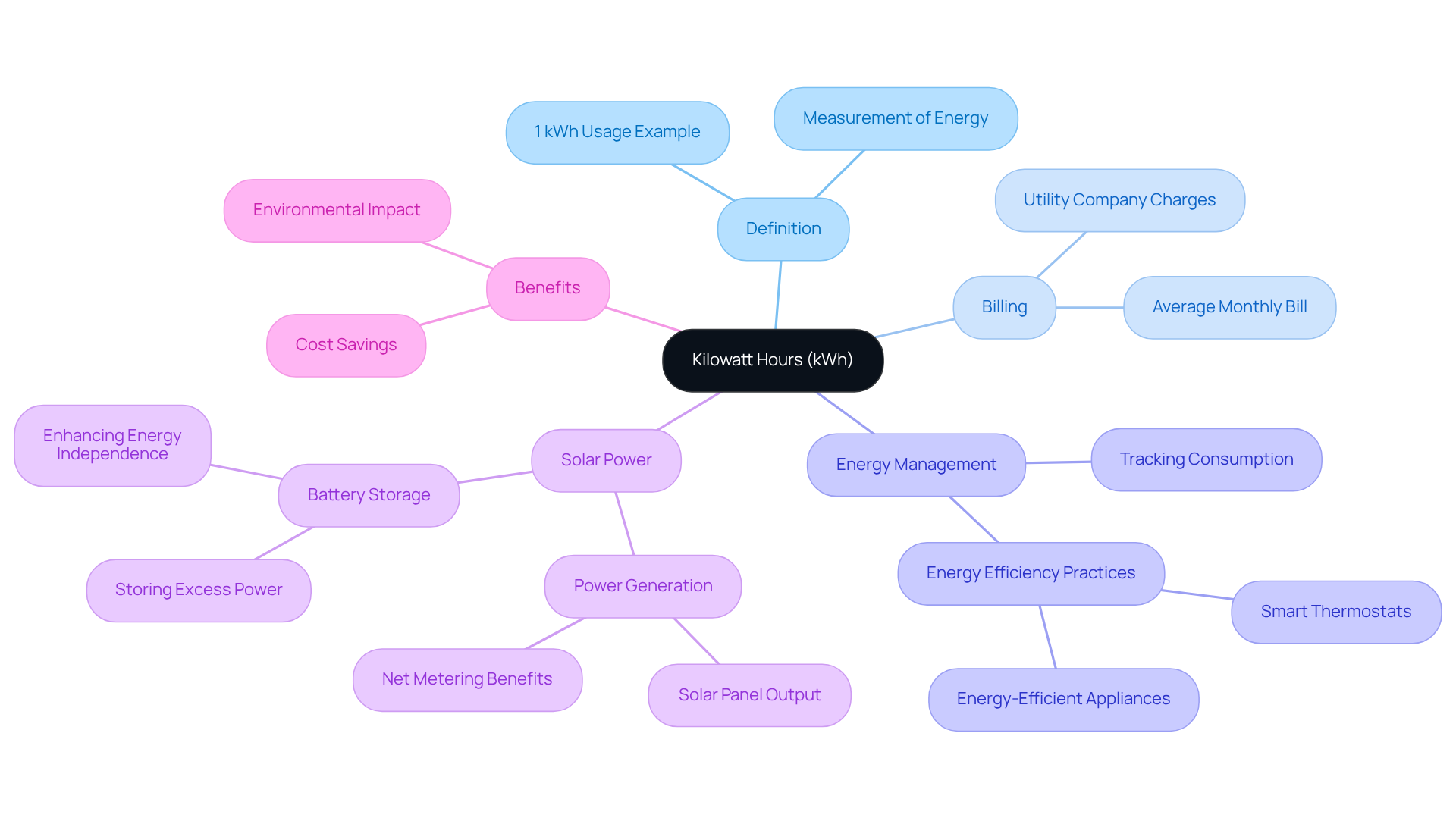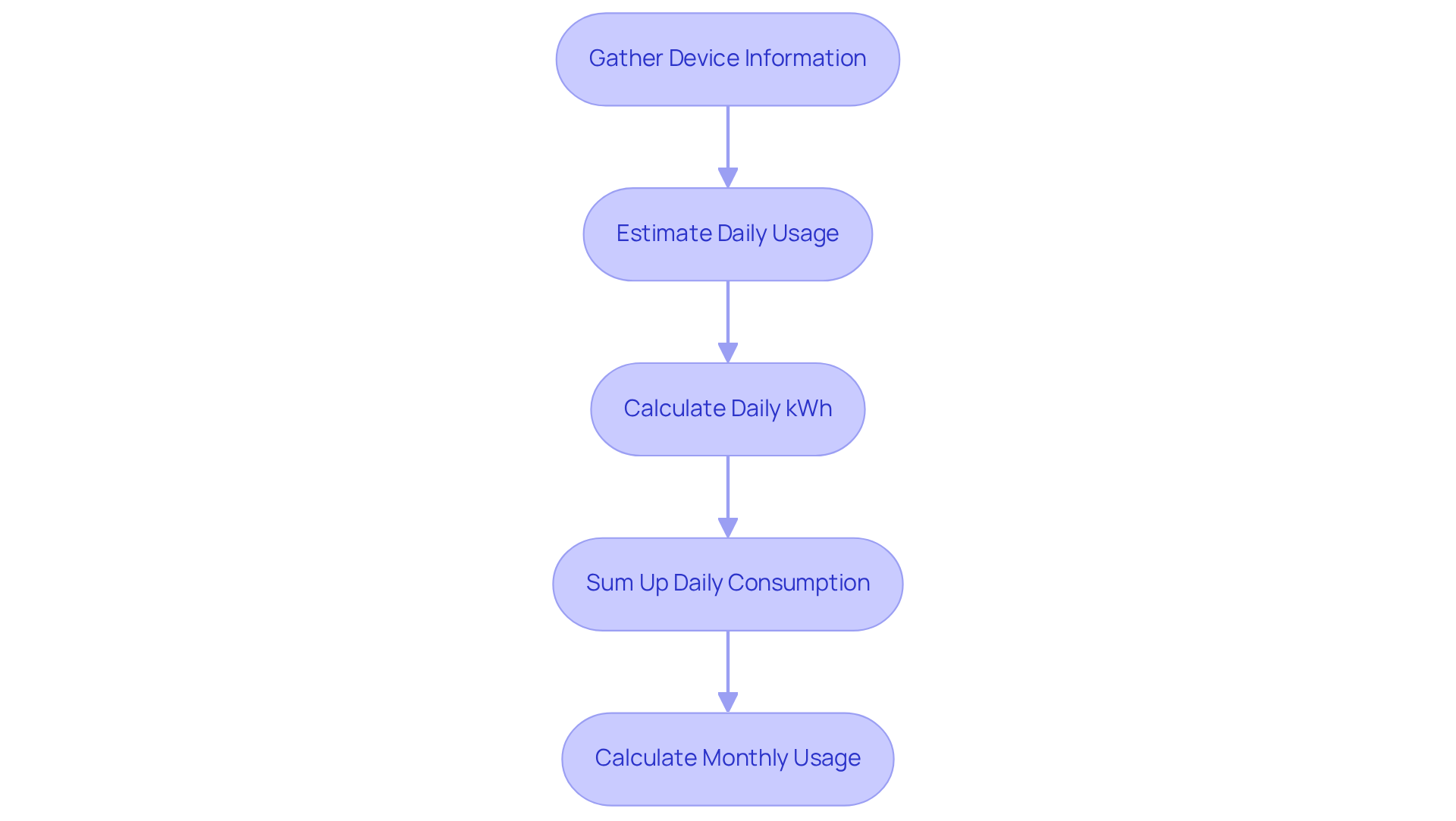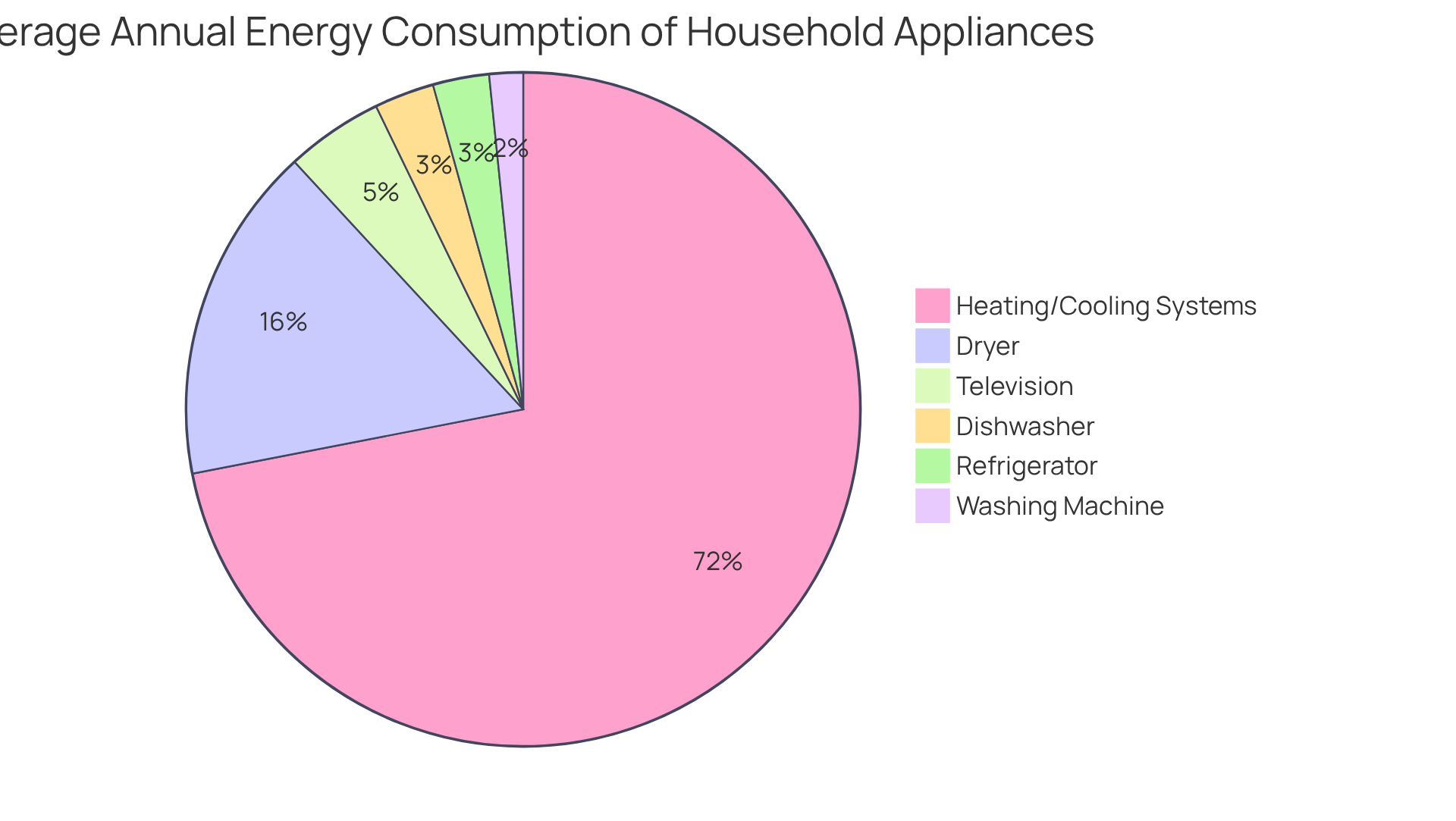Overview
Kilowatt hours (kWh) serve as a crucial measurement of electricity consumption, and we understand how important it is for eco-conscious homeowners like you to manage energy usage and costs effectively. By grasping the concept of kWh, you can track your energy consumption and explore ways to optimize it through energy-efficient appliances and strategies. This not only helps in reducing your utility bills but also lessens your environmental footprint.
Imagine the peace of mind that comes from knowing you’re making informed choices about your energy use. By embracing sustainable practices, you can take significant steps toward energy independence. Together, we can explore how small changes can lead to meaningful savings and a healthier planet.
Ultimately, understanding kWh is just the beginning. We’re here to support you every step of the way. Let’s work towards creating a more sustainable future together, ensuring that your home is both eco-friendly and cost-effective. If you have questions or need guidance, don’t hesitate to reach out—we’re here to help you on this journey.
Introduction
Understanding energy consumption is crucial for homeowners who are striving to reduce their utility bills and lessen their environmental impact. We recognize that navigating these concerns can be overwhelming.
Kilowatt hours (kWh) serve as a vital measurement of electricity usage, revealing insights into household energy patterns and potential savings. It’s common to wonder: how can you effectively manage and optimize your kWh consumption?
This guide delves into the significance of kilowatt hours, offering practical strategies for calculating usage and making informed decisions that lead to a more sustainable and cost-effective lifestyle. Together, we can explore solutions that not only benefit your wallet but also contribute to a healthier planet.
Define Kilowatt Hours and Their Importance
A kilowatt hour (kWh) is a measurement that indicates the quantity of electricity used when a device with a power rating of one kilowatt (1,000 watts) functions for one hour. We understand that managing energy bills can be a concern for homeowners, and is essential since utility companies bill for electricity based on kWh usage. For example, if you operate a 1,000-watt device for one hour, you will use 1 kWh of power. This measurement is vital for assessing your power usage trends and can assist you in recognizing opportunities for savings. By tracking your kWh consumption, you can make knowledgeable choices about efficient devices and methods, ultimately resulting in decreased utility costs and a diminished environmental footprint.
In the context of solar power, understanding how kilowatt hours work is particularly important as it relates to the amount of power your solar panels generate and how that power can be stored in batteries. It’s common to feel overwhelmed by the options available, but understanding how to manage that power can assist you in optimizing your consumption and storage. For instance, if your solar panel system generates 30 kWh in a day, investing in solar batteries allows you to store surplus power generated during the day for use at night or during cloudy days, enhancing your power independence.
Moreover, understanding how kilowatt hours work can help guide you in selecting the right solar panel system and battery storage solutions that meet your household’s energy needs. Together, we can make choices that not only reduce your electricity costs but also contribute to a more sustainable lifestyle. Let’s work towards a future where your energy independence is not just a dream but a reality.
Calculate Your Household’s Kilowatt Hour Usage
To calculate your household’s kilowatt hour usage, let’s take a moment to follow these simple steps together:
- Gather Device Information: Begin by listing all major machines in your home along with their wattage, which you can typically find on the device’s nameplate or in the user manual. This step helps you understand what’s consuming energy.
- Estimate Daily Usage: For each device, think about how many hours per day it is used. For instance, a refrigerator runs continuously (24 hours), while a washing machine may only be used for 1 hour. Reflect on your daily routines to make accurate estimates.
- Calculate Daily kWh: Use the formula:
Daily kWh = (Wattage × Hours Used Per Day) ÷ 1,000
For example, if a 200-watt appliance is used for 3 hours a day, the calculation would be: (200 × 3) ÷ 1,000 = 0.6 kWh. This calculation is a great way to visualize how do kilowatt hours work in terms of your energy consumption. - Sum Up Daily Consumption: Add the daily kWh for all appliances to get your total daily consumption. This total can be quite revealing.
- Calculate Monthly Usage: Multiply your total daily kWh by 30 to estimate your monthly usage. Knowing this figure can empower you to make informed decisions.
By following these steps, you can gain a clearer picture of how do kilowatt hours work in relation to your household’s power usage. We understand that in California, the typical household uses roughly each year, or about 412 kWh per month. This highlights the significance of tracking power consumption. Furthermore, devices such as refrigerators, ovens, and water heaters represent approximately 25% of typical household electricity usage. Comprehending your power consumption patterns is crucial for pinpointing areas where you can decrease usage and save on your utility bills. Together, we can explore energy-saving devices that often consume less electricity compared to older models, leading to significant savings and a more sustainable lifestyle.
Identify Energy Consumption of Common Appliances
Understanding how do kilowatt hours work is essential for managing your electricity expenses effectively by analyzing the . Did you know how do kilowatt hours work in the context that the average U.S. household uses about 10,500 kilowatt-hours (kWh) of electricity each year? This figure serves as a helpful benchmark for you to evaluate how do kilowatt hours work in relation to your own usage. Let’s take a closer look at some typical appliances and their average annual energy consumption:
- Refrigerator: 100-800 kWh, depending on its size and efficiency. Older models often consume more energy than newer, energy-efficient ones.
- Washing Machine: 180-360 kWh (15-30 kWh per month), influenced by your usage frequency.
- Dryer: 1,800-3,600 kWh (150-300 kWh per month), again based on how often it’s used.
- Dishwasher: 360-600 kWh (30-50 kWh per month).
- Television: 360-1,200 kWh (30-100 kWh per month), varying with size and viewing habits.
- Heating and Cooling Systems: 6,000-18,000 kWh (500-1,500 kWh per month), depending on the type of system and your consumption patterns. High-power devices like air conditioners and electric ovens typically use the most electricity.
To accurately assess how do kilowatt hours work in relation to your devices’ power consumption, consider using a power meter that connects to your outlet. This allows you to monitor each unit’s consumption closely. By identifying which devices consume the most energy, you can make informed decisions about replacing them with energy-efficient models or adjusting your usage habits. Moreover, keeping an eye on your power consumption can help you spot faulty devices that may be using more electricity than necessary, ultimately leading to significant savings on your utility bills.
Together, we can work towards a more sustainable energy future. It’s common to feel overwhelmed by energy costs, but by taking these steps, you’re on the path to greater energy independence and financial relief.
Implement Strategies to Optimize Kilowatt Hour Usage
Are you feeling overwhelmed by rising energy bills? You’re not alone. Many homeowners share this concern, and it’s completely understandable. To help you optimize your kilowatt hour usage and reduce those bills, consider implementing these nurturing strategies:
- Upgrade to Energy-Saving Appliances: Investing in ENERGY STAR-rated devices can be a game-changer. These appliances use significantly less power than standard models, leading to substantial savings over time. Imagine the relief of seeing lower bills each month!
- Utilize Smart Power Strips: We understand that phantom loads can be frustrating. Smart power strips can help by automatically disconnecting power to electronics that aren’t in use, preventing needless consumption. It’s a small change that can make a big difference.
- Adjust Thermostat Settings: Have you thought about your thermostat settings? Lowering it by a few degrees in winter and raising it in summer can lead to noticeable savings on heating and cooling costs. It’s a simple adjustment that can enhance your comfort.
- Seal Leaks and Insulate: Proper insulation and sealing of windows and doors can drastically reduce power loss. This not only minimizes the need for heating and cooling but also enhances your overall comfort. Let’s work towards a cozier home together!
- Utilize Natural Light: Embrace the beauty of daylight! By opening curtains and blinds during the day, you can reduce reliance on artificial lighting, cutting down on power consumption. It’s a wonderful way to brighten your space and save energy.
- Monitor Your Usage: Have you considered tracking your energy consumption? Using tools to observe your usage patterns can help you recognize areas for improvement. This awareness promotes a more conscious approach to resource use.
- Consider Solar Energy Solutions: If feasible, think about investing in solar panels from Powercore Electric. Generating your own electricity can significantly reduce your dependence on the grid, which raises the question of how do kilowatt hours work, ultimately lowering your kilowatt hour usage. Moreover, explore and roofing upgrades to further enhance your home’s efficiency and protection.
By adopting these strategies, you can not only significantly reduce your energy consumption and lower your utility bills but also contribute to a more sustainable future. Together, we can create a brighter, more energy-efficient world. If you need support or guidance, don’t hesitate to reach out!
Conclusion
Understanding kilowatt hours (kWh) is essential for homeowners who are concerned about managing their energy consumption effectively. We understand that energy bills can be daunting, and this measurement not only influences those bills but also serves as a critical tool for making eco-conscious decisions. By grasping how kWh works, you can optimize your energy usage, reduce costs, and contribute to a more sustainable lifestyle.
This article highlights several key points that address your concerns, including:
- The definition of kilowatt hours
- The importance of calculating household energy usage
- The energy consumption of common appliances
It offers practical steps for calculating kWh usage and suggests strategies for optimizing energy consumption, such as:
- Upgrading to energy-efficient appliances
- Utilizing smart power strips
- Considering solar energy solutions
These insights empower you to take control of your energy footprint and make informed choices that benefit both your finances and the environment.
Ultimately, the journey toward energy efficiency and sustainability begins with understanding and managing kilowatt hours. By implementing the strategies outlined, you can significantly reduce your energy bills while fostering a greener future. Taking proactive steps not only enhances your personal comfort but also contributes to a collective effort in creating a more energy-efficient world. Together, we can embrace these practices today to pave the way for a brighter, more sustainable tomorrow.





